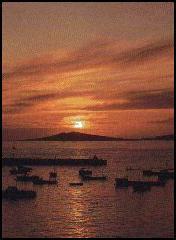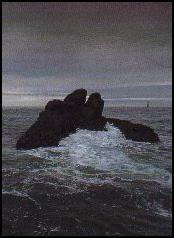Web: www.visitislesofscilly.com/explore/uninhabited-islands
Nobody's Islands
Visitors to the Isles of Scilly should not leave before taking the opportunity of a trip around the exposed fringes of the islands - the Western Rocks, the Norrard Rocks, the Eastern Isles, Tean, St. Helen's, Samson and Annet.

Samson with its unmistakable twin hills, covering about 120 acres and one and a quarter mile around, lies north west of St. Mary's, very close to Bryher, and once gave shelter to 36 families and six dwelling houses, but worn down by hard living, poor shelter and lack of water, the people moved away and Samson is now grown back to itself with sparse bracken, sea holly and sand dunes crossed with broken hedges marking the outlines of ancient fields. In 1855 Augustus Smith expelled the ten inhabitants of the island of Samson, to turn the island into a deer park (the deer did not like the habitat, and escaped.) Boat trips to Samson are regularly available May through September. There is no quay, so visitors disembark via wooden plank. The remains of the old cottages can be explored, and there are also the remains of Smith's deer park and prehistoric entrance graves. There are no amenities or services available, but guided walks are led by local experts.

Tean and St. Helen's are grouped together to the north east of Tresco. Tean was once used for grazing cattle and the outline of field walls can still be made out, particularly in the spring, St. Martin's families used to live on Tean during the summer months, burning seaweed for kelp, and the remains of their cottages can still be found. On St. Helen's can be found the remains of the oldest Christian building in the islands. St. Elidius, a British Bishop and the son of an English King, is reputed to be buried on the island and today, the Anglican church in Scilly holds a service at the site on the nearest Sunday to his feast day, August 8th. Lying just off St. Helen's is Round Island with its Lighthouse.
The rocks and islands of the Western Rocks are infamous for being the graveyard of countless ships through the centuries. From Annet, the bird sanctuary, to the Bishop Rock Lighthouse the untamed wildness and the cruel granite outcrops are the home to colonies of sea birds and grey Atlantic seals. Puffins arrive in the islands to nest in the spring and regular boat trips to see them are organised by the islands' boatmen from April to late July.
The Eastern Isles near St. Martin's have more grassy cover than the other inhabited islands and important discoveries of habitation from around AD69 have been found on Nornour and can be seen in the St. Mary's Museum. Pre-historic graves have been found on Great Ganilly and Great Arthur. Sea birds and seals can be seen in great numbers and at close quarters when cruising around the Eastern Isles.
The Isles of Scilly
St. Mary's St. Martin's Bryher Tresco St. Agnes